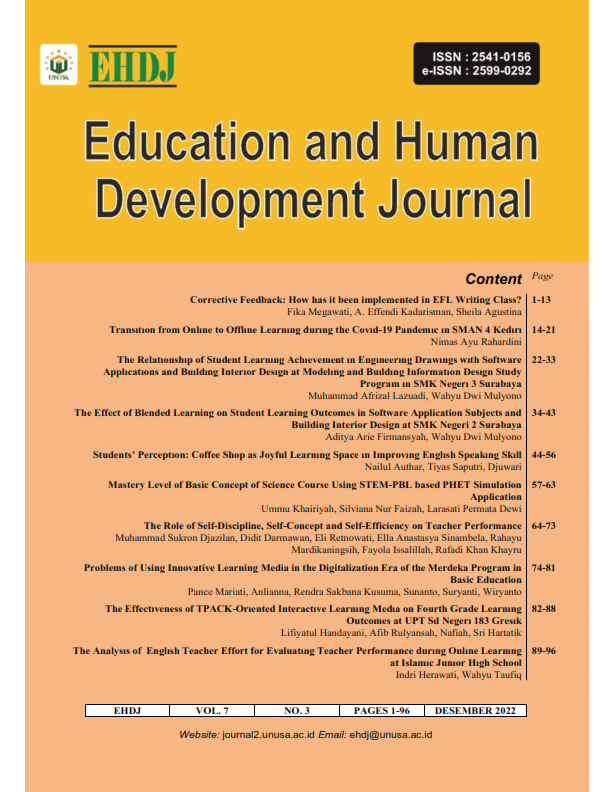Students’ Perception: Coffee Shop as Joyful Learning Space in Improving English Speaking Skill Anxiety, comfortable place, Internal motivation, external motivation, joyful learning
##plugins.themes.bootstrap3.article.main##
Abstract
Learning English requires a special condition so that the learners can learn English, especially speaking skill, without anxiety. For that reason, preparing a comfortable place is essential for making the learners motivated to learn or at least to make them like English. This study attempts to explore the students of the customers in a coffee shop to learn English informally. It took 4 respondents of the coffee shop, at Djuw Cafe, selected by purposive sampling with the criteria as the loyal customers who very often come to the coffee shop. They were interview unintentionally with unstructured interview and observation by the researcher. The interview was also done with the owner of the coffee shop. These sources of data then interpreted and classified into the domain with the themes based on the semantic meanings. These themes then were analyzed and interpreted, and finally drawn the inferences for conclusion. It was found that the most essential factor that makes the respondents highly motivated to learn English is the listening of English songs. Secondly, they are motivated to enjoy learning English through the written English expressions that are decorated on the walls. Therefore, making the learners motivated to learn English, it requires a comfortable place with a specific design of the place with English songs and some written English expression for the decoration on the wall.
Downloads
##plugins.themes.bootstrap3.article.details##
Copyright (c) 2022 Nailul Authar, Tiyas, Djuwari

This work is licensed under a Creative Commons Attribution-ShareAlike 4.0 International License.
References
Brown, H. 2007. Principles of Language Teaching and Learning Fifth Edition. White Plains, NY: Pearson: Longman.
Burns, A. 2010. Doing Action Research in English Language Teaching: a Guide for Practitioners. New York: Routledge. DOI: https://doi.org/10.4324/9780203863466
Chen, Y. (2015). ESL students' language anxiety in in-class oral presentations
Djuwari, D., Saputri, T., & Authar, N. (2022). A Comparative Study of Rhetorical Moves in Introduction Section of International Journal Articles. SPECIALUSIS UGDYMAS / SPECIAL EDUCATION, 1(43), 5617–5629. Retrieved 2022, from https://www.sumc.lt/index.php/se/article/view/709.
Effiong, O. (2016). Getting them speaking: Classroom social factors and foreign language anxiety. Tesol Journal, 7(1), 132-161. DOI: https://doi.org/10.1002/tesj.194
Gardner, H. (2006). The Development and Education of the Mind. New York: Routledge. DOI: https://doi.org/10.4324/9780203019689
Gate, M. (2003). Language Teaching: A Scheme for Teacher Education; Speaking. Oxford: Oxford University Press
IDN Times 2022. Accessed from IDN Times. On August 17, 2022 from: https://www.idntimes.com/tag/coffee-shop
Hadfield, J. (1996). Intermediate Communicative Games. Edinburg: Addison Wesley Longman Ltd.
Harmer, J. (2001). The Practice of English Language Teaching (3rd ed.). Edinburgh: Longman
Jamshed, S. (2014). Qualitative research method-interviewing and observation. Journal of basic and clinical pharmacy, 5(4), 87. DOI: https://doi.org/10.4103/0976-0105.141942
Mills, G. E. (2003). Action Research: A Guide for the Teacher Researcher. New Jersey: Merril Prentice Hall.
Klonis, S. C., Plant, E. A., & Devine, P. G. (2005). Internal and external motivation to respond without sexism. Personality and Social Psychology Bulletin, 31(9), 1237-1249. DOI: https://doi.org/10.1177/0146167205275304
Pappamihiel, N. E. (2002). English as a second language students and English language anxiety: Issues in the mainstream classroom. Research in the Teaching of English, 327-355., accessed on August 17, 2022, from : https://www.jstor.org/stable/40171530
Plant, E. A., & Devine, P. G. (1998). Internal and external motivation to respond without prejudice. Journal of personality and social psychology, 75(3), 811. DOI: https://doi.org/10.1037/0022-3514.75.3.811
Richards, J. 2006. Communicative Language Teaching Today. Cambridge: Cambridge University Press.
Richards, J. 2008. Teaching Listening and Speaking from Theory to Practice. Cambridge: Cambridge University Press.
Simanjuntak, B., & Limbong, T. (2018). Using Google form for student worksheet as learning media. International Journal of Engineering & Technology, 7(3.4), 321-324
Sriprakash, Arathi. 2009. Joyful Learning in rural Indian Primary Schools: an Analysis of social control in the context of child –centered discourses. Cambridge: University of Cambridge DOI: https://doi.org/10.1080/03057920903125677
Thornbury, S. 2005. How to Teach Speaking. London: Longman.
Vannette, D. L., & Krosnick, J. A. (Eds.). (2017). The Palgrave handbook of survey research. Springer. DOI: https://doi.org/10.1007/978-3-319-54395-6

